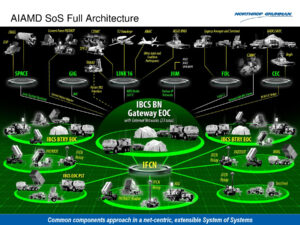
Will Roper
WASHINGTON: Commercial firms with expertise in data analytics, machine learning and AI are the highest priority targets for new contract awards under the Air Force’s high-priority Advanced Battle Management System (ABMS), says service acquisition czar Will Roper.
And he wants them on board fast, he told reporters today, hoping awards can be made within a month to six weeks. Roper did not, however, provide an estimated value.
Roper said some 300 companies are participating in the ABMS Virtual Industry Days that started yesterday and run through tomorrow — including many outside the traditional DoD industrial base. Up to now, only about a dozen companies have been granted actual contracts under ABMS, a number of them major DoD contractors such as Northrop Grumman, he said.
Speaking in front of a virtual backdrop of the “Star Wars” Millennium Falcon, Roper said that desire is the key reason behind ABMS issuing not one, but three, Broad Agency Announcements (BAAs) to solicit industry input.
“We want a wide variety of companies, and we definitely want fresh blood in the ABMS competition pool,” Roper said. “There is a lot that can be contributed from companies that are commercially focused that know a lot about data, that know a lot about machine learning and AI, and that know a lot about analytics. Those are going to be the most important parts of the Advanced Battle Management System.”

ABMS construct
The ABMS family of systems is being designed as a key part of the multi-service Joint All Domain Command and Control (JADC2) concept to link every sensor to every shooter via a military Internet of Things. JADC2 in turn is one of the top priorities for Chairman of the Joint Chiefs of Staff Mark Milley and Secretary of Defense Mark Esper, as well as current Air Force Chief of Staff Gen. David Goldfein, as they attempt to map out a new American way of war.
The idea is that some of those companies can be contracted and ready to demonstrate capability during the next ABMS On Ramp, newly scheduled for Aug. 31 through Sept. 4.
That exercise, which will be the second ABMS On Ramp, was initially was planned for last month, but was postponed due to the COVID-19 crisis. It will involve a space-oriented scenario, including Space Command, Space Force, and Northern Command (NORTHCOM) among other DoD players.
Roper said he is hopeful the ongoing demonstrations will be able to “demystify” ABMS, which has faced considerable pushback for its innovative approach to both development and acquisition — involving four-month spiral development cycles toward no fixed capability requirements. This includes concerns voiced by the Government Accountability Office as well as the other services.
“I think there’s a lot of fear of ABMS,” Roper said. “Look, we’ve never built anything like this. And the names are weird, and the acquisition is weird. [And with] anything that you don’t understand, the Department usually starts with fear: what’s it going to take over; what’s it going to get control of?”
Air Force officials participating in a webinar yesterday sponsored by the Missile Defense Advocacy Alliance also went out of their way to make clear that the service does not see the ABMS as controlling other service choices on how to implement JADC2. The Army in particular has been vocal in slapping back at even the tiniest hint that the Air Force’s ABMS efforts might be aimed at appropriating JADC2 management (and the related budget authorities) for itself.
Brig. Gen. David Kumashiro, the Air Force’s JADC2 Cross-Functional Team leader, admitted during the webinar that the service’s enthusiasm for ABMS sometimes “comes across like a hostile takeover” of other service’s plans for JADC2, but stressed it is nothing of the sort.

A simplified (yes, really) overview of the Army’s IBCS command-and-control network for air and missile defense.
“Each of the services have made significant investments trying to get at this JADC2 problem. With that being said, each of the services have different platforms and different tactical edge devices that they need to ensure can can link to the larger collective,” he said.
“There is no, I think, debate about the approach that ABMS is taking in terms of what we’re focused on,” he stressed. “But, I think, it’s just about how you get there and just ensuring the systems that they have in place. We definitely don’t want to orphan those systems out — they’re part of, obviously, the collective that is the Joint Force.”
Instead, Kumashiro explained, ABMS is first of all the Air and Space Force’s approach to linking to the future JADC2 network. “ABMS is an approach to build out the connective tissue,” he said. “ABMS is what the Air Force and the Space Force need to be able to connect in the 21st century, and then to connect with the Joint Force.”
Then, he elaborated, ABMS is being designed and developed so the Air and Space Forces can also link back to the tactical edge, and thus connect to the systems being used by the Navy and the Army. These include the Army’s IBCS air and missile defense network, and the Navy’s Naval Integrated Fire Control – Counter-Air (NIFC-CA) network.
“It’s a system of systems — a family of systems — that we will then be able to connect with IBCS, will be able to connect with the naval tactical grid, to ensure that that data flows, the information flows, at machine speed so that we can maintain decision advantage over over adversaries,” Kumashiro explained.
IBCS is an awkward nested acronym for Integrated Air & Missile Defense (IAMD) Battle Command System. The network is intended to share data and commands seamlessly among a wide range of historically incompatible systems across the Army and, potentially, the other services.
NIFC-CA is the Navy’s key multi-domain C2 network, which links airborne sensor platforms with surface ships. NIFC-CA allows E-2D Advanced Hawkeye radar planes and F-35C Joint Strike Fighters to spot enemy aircraft or incoming missiles, then transmit the data to Aegis cruisers and destroyers, or even Littoral Combat Ships, which can then fire on targets they can’t see with their own radars.
Roper elaborated that the central role of ABMS is to manage and rapidly move data and information to decision-makers. “What it actually is going to do is just make data available to users that’s relevant to them. And as they interact with that data, the data will get better,” he said, just like commercial platforms such as Google’s search engine does.
The irrepressible Roper also waxed enthusiastic about how the use ABMS tools, such as deviceONE and dataONE, in the COVID-19 crisis by NORTHCOM, as I reported last week, is serving as a real-world example of what ABMS will be able to do for the warfigher.
DeviceONE currently allows selected US military, DoD and Intelligence Community personnel to access Secret-level technology from an unclassified laptop. DataONE allows classified and unclassified data from a variety of sensors to be stored in the cloud, to be accessed by users only at the level they are authorized to see.
“If the Joint Force can just get a taste of what this will be like on the battlefield, it will be the most addictive drug that has ever been made for warfare,” he said. “Data is the ultimate currency in any particular field today, it’s the most valuable thing on Earth. It’ll be the most valuable thing on the battlefield.”
Outside of ABMS, Roper’s acquisition mavericks are gearing up for two other major virtual events that he hopes will lead to fundamental changes in how the Air Force does business.
Roper is participating in this year’s virtual version Aug. 6-9 of DEF CON, the world’s biggest convention of hackers, to stand up a new “aerospace village.” The “village” will include talks and demos by both aviation and space companies, and is aimed at raising awareness of cyber vulnerabilities in air and space technologies. The central event will be the “Hack-A-Sat” competition, where hackers will try to hack a satellite and/or its ground station in real time. Roper said some 900 hackers have signed up already for a go.
Roper is trying to build up the Air Force’s profile among so-called White Hat hackers (the good guys). The hope is to eventually figure out a way to bring them into the design cycle of future programs, in order to suss out cyber vulnerabilities early in the process — something that would turn current DoD ambivalence about the broader hacker culture on its head.
“We’ve got amazing hackers in the Air Force — I’ve just been amazed by what they’re able to do. But we don’t have enough of them,” he said.
In addition, Roper said the Air Force is holding a “Virtual Quantum Collider” pitch day on June 15-16, which is aimed at enabling small business innovation in order to quickly transfer advanced quantum technologies to warfighters.
“So, the idea is to bring about $50 million to help spin out companies from university research to fund fundamental research,” Roper said.
Quantum science holds the potential to revolutionize everything from communications to cybersecurity to even improved positioning, timing and navigation, and is one of the high-priority technology focuses for DoD’s Office of Research and Engineering headed by Mike Griffin.
In a Taiwan conflict, tough choices could come for Big Tech
Washington could do more to incentivize tech companies to distance themselves from China, but CEOs should examine how they’d react to a fight in the Pacific, CSET’s Sam Bresnick and Emelia Probasco argue.



























